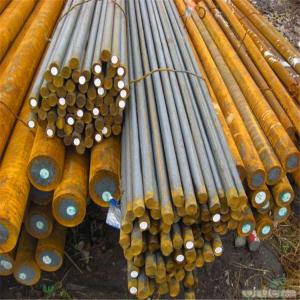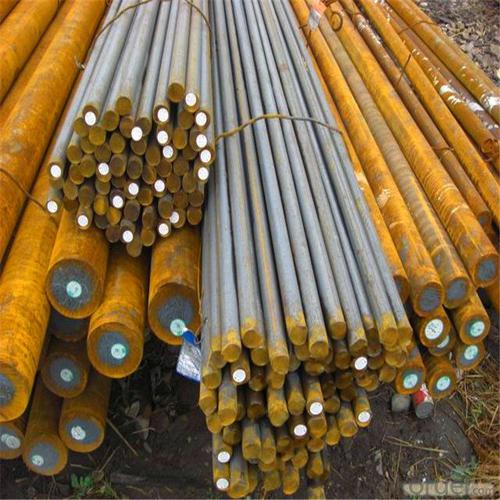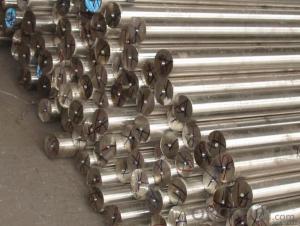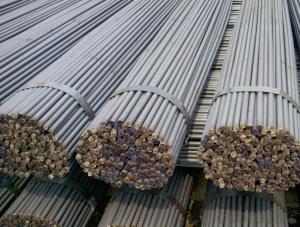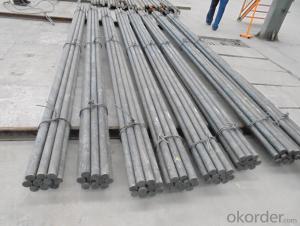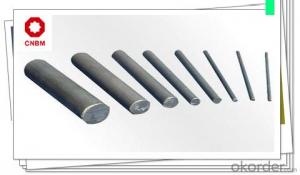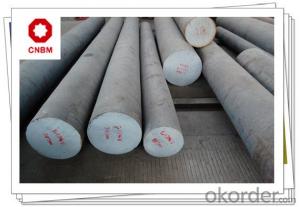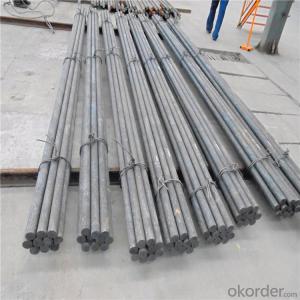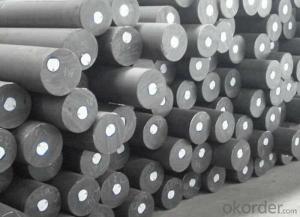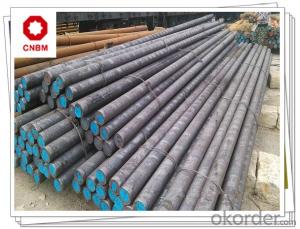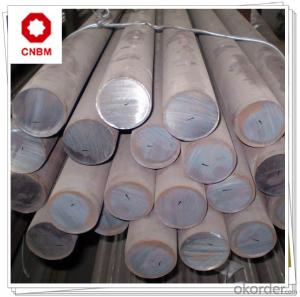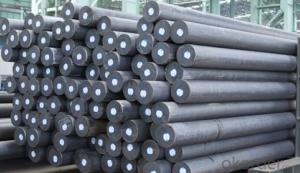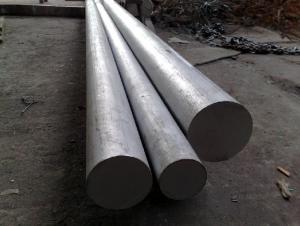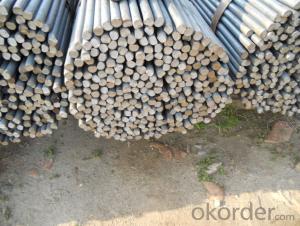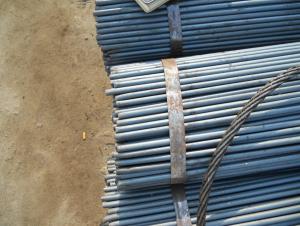Hot Rolled Steel Round Bar S20C
- Loading Port:
- Tianjin
- Payment Terms:
- TT OR LC
- Min Order Qty:
- 100 m.t.
- Supply Capability:
- 500000 m.t./month
OKorder Service Pledge
OKorder Financial Service
You Might Also Like
Specification
Hot Rolled Steel Round Bar S20C
Product Description of Hot Rolled Steel Round Bar S20C
1. Steel grade: SAE1020, 20#, C22, S20C
2. Length: 6M-12M
3. Diameter: 16mm-300mm
4. Product range: round bar, flat bar, square bar
5. Technique: Hot rolled, forged, cold drawn
Specification of Hot Rolled Steel Round Bar S20C
Material | S20C | Round bar | Dia(mm) | 16-300mm |
Process | EAF + LF + VD + Forged + Heat Treatment (optional) | Length (mm) | Max 12m | |
Heat treatment | Normalized / Annealed / Quenched / tempered | Flat bar | Thickness(mm) | 8-500mm |
Delivery condition | Hot forged +Rough machined (black surface after Q/T)+ Turned (optional) | Width(mm) | 70-200mm | |
Test | Ultrasonic test according to SEP 1921-84 D/d | Length (mm) | Max 12m |
Chemical Composition of Hot Rolled Steel Round Bar S20C
C | Si | Mn | Cr | Ni | Cu |
0.17~0.23 | 0.17~0.37 | 0.35~0.65 | ≤0.25 | ≤0.30 | ≤0.25 |
Photo Show of Hot Rolled Steel Round Bar S20C
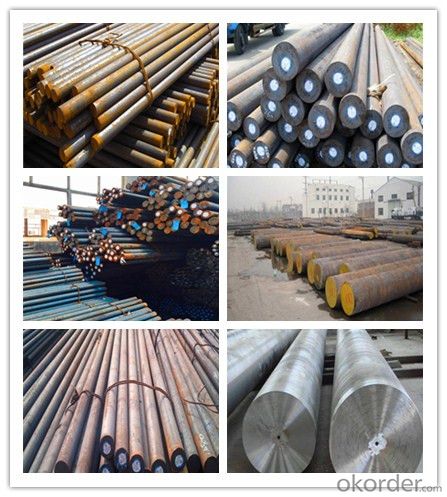
Packing and Delivery:
Packing in bundle package, or as customer's requirements.
Delivery Detail: 45 days after receiving the deposit.
Usage and Applications of Hot Rolled Steel Round Bar S20C
1. Steel round bar is used in a large number of architectural and engineering structures. Or it can be used in construction of plants for the production of steel house frames, high-voltage transmission towers, bridges, vehicles, boilers, containers, ships, etc.
2. And we can use this kind of product on the performance of the mechanical parts if the demand is not very high.
3. Some special material steel round bar can be used for main shaft of steamer, hummer shank, with big section and supper force.
Company Information
CNBM International Corporation is the most important trading platform of CNBM group.
Whith its advantages, CNBM International are mainly concentrate on Cement, Glass, Iron and Steel, Ceramics industries and devotes herself for supplying high qulity series of refractories as well as technical consultancies and logistics solutions.

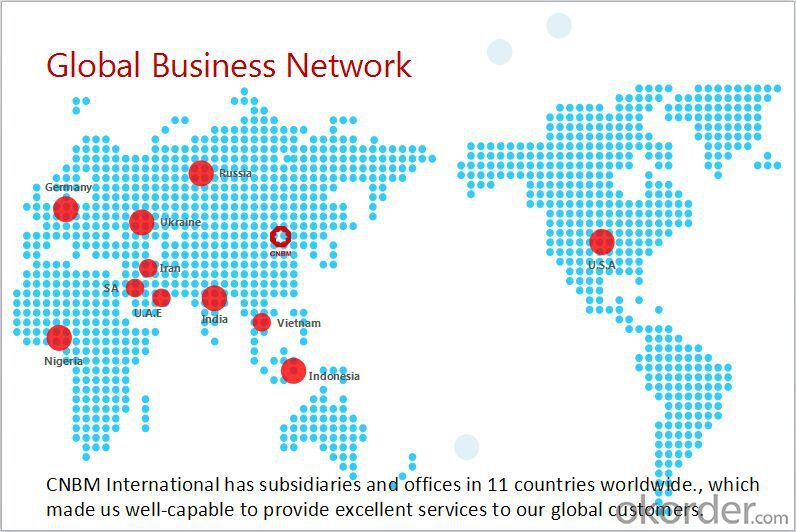
F A Q
1, Your advantages?
professional products inquiry, products knowledge train (for agents), smooth goods delivery, excellent customer solution proposale
2, Test & Certificate?
SGS test is available, customer inspection before shipping is welcome, third party inspection is no problem
3, Factory or Trading Company?
CNBM is a trading company but we have so many protocol factories and CNBM works as a trading department of these factories. Also CNBM is the holding company of many factories.
4, Payment Terms?
30% TT as deposit and 70% before delivery.
Irrevocable L/C at sight.
5, Trading Terms?
EXW, FOB, CIF, FFR, CNF
6, After-sale Service?
CNBM provides the services and support you need for every step of our cooperation. We're the business partner you can trust.
For any problem, please kindly contact us at any your convenient time.
We'll reply you in our first priority within 24 hours.
- Q: What is the difference between a cold-drawn and a centerless ground steel round bar?
- A cold-drawn steel round bar is produced by pulling the steel through a die at room temperature, resulting in increased hardness and improved surface finish. On the other hand, a centerless ground steel round bar is produced by grinding the outer diameter of the steel bar to achieve tight dimensional tolerances and a smooth surface finish. In summary, the main difference lies in the manufacturing process and the resulting properties and finish of the steel round bar.
- Q: Can steel round bars be used for making turbine blades?
- No, steel round bars cannot be used for making turbine blades. Turbine blades are subjected to high temperatures, extreme forces, and require high levels of durability and flexibility. Steel round bars do not possess the necessary properties to withstand these conditions. Turbine blades are typically made from materials such as titanium alloys or advanced composites that offer high strength-to-weight ratios, excellent fatigue resistance, and thermal stability. These materials are specifically engineered to withstand the demanding conditions of turbine operations, ensuring efficient and reliable performance.
- Q: How do you measure the diameter of a steel round bar?
- To measure the diameter of a steel round bar, you can use a caliper or a micrometer. Simply place the measuring tool across the widest point of the bar and read the measurement displayed on the tool.
- Q: What are the different cutting methods used for steel round bars?
- The cutting of steel round bars can be done using various methods, depending on the specific requirements and available tools. Here are some commonly used cutting methods: 1. Sawing: Traditional sawing using a saw blade is a cost-effective and simple method suitable for smaller diameter round bars. 2. Abrasive Cutting: When cutting thicker and harder steel bars, abrasive cutting with an abrasive wheel or disc proves to be highly effective. It is often used in industrial applications where precision and speed are crucial. 3. Plasma Cutting: This thermal cutting method involves using a high-velocity jet of ionized gas to melt and remove the metal. It is suitable for cutting steel bars of different thicknesses and is renowned for its speed and precision. 4. Laser Cutting: Laser cutting is an efficient and precise method that utilizes a high-powered laser beam to melt and vaporize the metal. It is commonly employed for cutting intricate shapes and patterns in steel round bars. 5. Waterjet Cutting: Waterjet cutting utilizes a high-pressure stream of water mixed with an abrasive material to cut through steel bars of varying thicknesses and types. It is a versatile method. 6. Shearing: This cutting method involves using specialized machine blades to swiftly and accurately cut smaller diameter round bars. When considering the cutting method for steel round bars, it is crucial to carefully assess the project's specific requirements and consult with experts to determine the most suitable approach.
- Q: Can steel round bars be used in the manufacturing of pumps?
- Yes, steel round bars can be used in the manufacturing of pumps. Steel round bars are commonly used in various industries for their strength, durability, and versatility. In pump manufacturing, steel round bars are often used as shafts or rotors due to their ability to withstand high pressure and rotational forces. The steel round bars can be machined, forged, or heat-treated to meet the specific requirements of the pump design. Additionally, steel round bars provide excellent corrosion resistance, making them suitable for pumps used in various environments. Overall, steel round bars are a reliable and commonly used material in pump manufacturing.
- Q: What are the different surface roughness options for steel round bars?
- Steel round bars offer several surface roughness options, which are determined by the manufacturing process and the intended end-use. 1. Hot Rolled bars have a rough and scaled surface due to the high temperature during formation, causing oxidation and scale formation. The degree of roughness varies based on the manufacturing process. 2. Cold Drawn bars, processed at room temperature, provide a smoother surface finish compared to hot rolled bars. The cold drawing process reduces diameter through a die, resulting in a more consistent roughness. 3. Peeled and Polished bars undergo a secondary process to eliminate scale and surface defects. This involves peeling the outer layer and polishing the surface for a refined finish with minimal imperfections. 4. Ground bars are processed using a grinding machine to achieve precise and smooth surface finish. Irregularities and defects are removed, ensuring a uniform roughness. These bars are ideal for applications requiring dimensional accuracy and a smooth surface. 5. Turned and Polished bars are processed on a lathe machine, removing the outer layer using a cutting tool. This process yields a smooth and polished finish, making them suitable for applications where aesthetics and high-quality surface are crucial. Ultimately, the choice of surface roughness option for steel round bars depends on specific application requirements. Factors like dimensional accuracy, surface finish, and aesthetics influence the most suitable option for a given use case.
- Q: Are steel round bars suitable for use in the automotive industry?
- Indeed, the automotive industry finds steel round bars to be a fitting option. Steel round bars possess numerous advantages that render them an ideal choice for automotive applications. Primarily, steel round bars exhibit exceptional strength and durability, which are vital characteristics for automotive components that must endure significant levels of stress and impact. The high tensile strength of steel guarantees that these components can handle the demanding conditions of the automotive industry, including heavy loads and harsh environments. Additionally, steel round bars offer favorable machinability, enabling them to be easily shaped and fabricated into a variety of automotive parts. This versatility is crucial for producing components with intricate geometries, such as crankshafts, axles, and suspension parts. Furthermore, steel round bars present superior dimensional stability, ensuring that automotive parts retain their shape and performance over time. This is particularly crucial for critical components that must meet precise specifications and tolerances. Moreover, steel round bars boast excellent heat resistance, allowing them to be used in applications that involve high temperatures, such as engine components and exhaust systems. The thermal stability of steel ensures that these parts can operate efficiently and reliably under extreme heat conditions. Furthermore, steel is readily available and cost-effective when compared to other materials, making it an appealing option for the automotive industry. The abundance of steel resources and the well-established manufacturing processes contribute to its affordability, making it a practical choice for mass production. In conclusion, steel round bars are highly suitable for use in the automotive industry due to their strength, durability, machinability, dimensional stability, heat resistance, and cost-effectiveness. These qualities make steel round bars an excellent choice for various automotive components, thereby enhancing the overall performance, safety, and longevity of vehicles.
- Q: What are the common defects found in steel round bars?
- Steel round bars may possess several common defects, including surface cracks, internal voids, inclusions, segregation, and dimensional variations. Surface cracks can arise from manufacturing processes or improper handling and transportation, resulting in compromised structural integrity and reduced load-bearing capacity. Internal voids, also known as blowholes or cavities, emerge as empty spaces within the steel caused by trapped gases during solidification. These voids can detrimentally affect the mechanical properties of the bar, rendering it more susceptible to failure under stress. Inclusions, non-metallic particles or impurities, may be present in the steel. They may originate from raw materials used in production or contaminants introduced during manufacturing. Inclusions diminish the strength and ductility of the steel and can serve as starting points for cracks. Segregation refers to the uneven distribution of elements within the steel. It can occur during solidification, leading to areas of the bar with distinct chemical compositions. Consequently, variations in mechanical properties, such as hardness and toughness, arise, resulting in inconsistent performance. Defects can also manifest as dimensional variations, such as out-of-roundness or fluctuations in diameter. These variations impact the bar's fit and functionality, especially in applications requiring precise dimensions. To ensure the quality and reliability of steel round bars, particularly in applications demanding high strength and performance, it is crucial to identify and rectify these defects. Regular inspections, implementation of quality control measures, and adherence to industry standards and specifications aid in minimizing these defects and upholding the integrity of steel round bars.
- Q: What are the different types of connections used with steel round bars?
- There are several types of connections commonly used with steel round bars, depending on the specific application and structural requirements. Some of the different types of connections include: 1. Welded Connections: This is one of the most common types of connections used with steel round bars. Welding involves fusing two or more round bars together using heat and pressure. It provides a strong and durable connection. 2. Mechanical Connections: Mechanical connections involve using bolts, nuts, or other mechanical fasteners to join steel round bars together. These connections are easy to install and can be disassembled if needed. They are commonly used in applications where frequent disassembly or reconfiguration is required. 3. Threaded Connections: In threaded connections, the steel round bars have threads cut into their ends, allowing them to be screwed together using nuts. This type of connection offers good strength and can be easily tightened or loosened. 4. Adhesive Connections: Adhesive connections involve using a high-strength adhesive or epoxy to bond steel round bars together. This type of connection is commonly used in applications where welding or mechanical connections are not feasible or desirable. 5. Interlocking Connections: Interlocking connections involve the use of specially designed couplers or connectors that fit over the ends of steel round bars, creating a secure connection. These connections are often used in construction projects where quick and efficient installation is required. 6. Grouted Connections: Grouted connections involve filling the gaps between steel round bars with a cementitious grout material. This helps to provide additional strength and stability to the connection. Grouted connections are commonly used in applications where high load capacities are required. It is important to choose the appropriate type of connection based on the specific requirements of the project, considering factors such as load capacity, installation ease, disassembly requirements, and structural integrity. Consulting with a structural engineer or a professional in the field is recommended to ensure the correct type of connection is chosen for the steel round bars.
- Q: Are steel round bars suitable for architectural applications?
- Yes, steel round bars are suitable for architectural applications. They offer strength, durability, and versatility, allowing them to be used in various architectural designs such as railings, sculptures, and decorative elements. Steel round bars can be easily fabricated and have a sleek and modern aesthetic, making them a popular choice in the architectural industry.
Send your message to us
Hot Rolled Steel Round Bar S20C
- Loading Port:
- Tianjin
- Payment Terms:
- TT OR LC
- Min Order Qty:
- 100 m.t.
- Supply Capability:
- 500000 m.t./month
OKorder Service Pledge
OKorder Financial Service
Similar products
Hot products
Hot Searches
Related keywords
